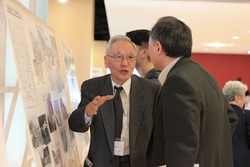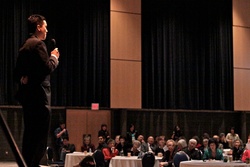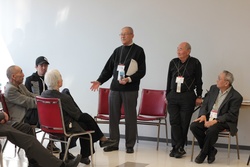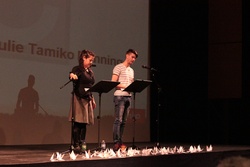On the weekend of March 31-April 1, I traveled to Toronto to attend the Keisho Conference at the Japanese Canadian Cultural Centre. The conference, organized by the Heritage Committee of the JCCC (with help from Sedai, the Japanese Canadian Legacy Project) was designed to commemorate the 70th anniversary of Japanese Canadian confinement. There were a few hundred Japanese Canadians in attendance, plus some non-Japanese. On the morning of the first day, we were seated in the large Kobayashi hall, which was dotted with round tables and chairs for the occasion. I sat with a friendly contingent of Nisei women from Hamilton, Ontario.
The conference started with plenary presentations. There were some great opening remarks by emcee Lorene Nagata (who had organized the Heritage Committee’s fall 2010 conference), an official welcome by JCCC president Gary Kawaguchi, and a virtual tour through Sedai’s website and activities with staffer Lisa Uyeda. The morning’s big event was the sneak preview of Chris Hope’s very moving documentary film Hatsumi : One Grandmother’s Journey Though the Japanese Canadian Internment.
I had seen a video of the film in rough cut, but it was still amazing to see the finished product on the big screen. The film recounts how the filmmaker, a young sansei-yonsei, had his grandmother literally revisit her wartime experience by bringing her to her surviving prewar home in British Columbia and then taking her through the confinement sites. The film’s emotional climax is the grandmother’s reunion with her long-separated brother in Japan. After the film came the Q&A in which staffer Constantin heroically ran to give audience members the mic and Chris bravely tried to elicit and field questions and comments.
Chris’s film draws both its power and much of its value from the fact that he was able to get his grandmother to talk about her experience and share the story of her difficult wartime plight. I think that Hatsumi crystallized the desire on the part of the younger members of the community to find the stories of their family members, and the larger community as a whole, to give them a sense of themselves. As with Japanese Amercans, with Japanese Canadians there is a kind of double sense of legacy from the wartime removal—a kind of suitcase metaphor—as both the (negative) baggage the community carries and that weighs down, and the (positive) sense of what is carried forth into the future. I know that I heard throughout the day from Sansei who greatly regret that their parents did not tell their stories of their experience while they were alive, either because the parents did not want to burden their children with pain or because they themselves wanted to forget.
After the film and Q&A there was a box lunch served. This was a very nice idea, because it gave us time to socialize. I had the pleasure of lunching with Frank Moritsugu, Roy Matsui and Min Yatabe, a trio of Canadian Army veterans of WWII. They were among the very few Nisei about 150 in all) who were able to enlist in Canada’s Army at the close of World War II, and who dedicated themselves to serving their country and proving their loyalty to a Canada that had given them the back of its hand.
It was a special treat to meet Frank Moritsugu because he is such a fascinating figure. He became a journalist after the war, writing for the New Canadian and for such diverse publications as Canadian Homes and Gardens and The Montreal Star. Later he put together a book, Teaching in Canadian Exile, about the Nisei who taught in the wartime "ghost towns" and camps. I shamelessly pumped him for stories about his journalistic career and his time in Montreal.

Dr. Arai points out photographs from the war years to Mr. Fujisawa. This architect heard about the conference and came in all the way from Wisconsin to attend.
During Saturday afternoon, the conference offered a choice of different workshops. The first group of sessions, which covered the war years, featured Nisei speaking of their experience, with the aid of various facilitators. I attended a session on the so-called "self-supporting sites". During 1942, Issei and Nisei who could show that they had the means ($1800 in the bank) were permitted to move themselves and settle in a select number of areas, and thereby avoid involuntary confinement. The session was fascinating because I had had very little information on these "sites"—there is no book on the subject.
I learned that there was no set pattern as to who or why they decided to go self-supporting, that they were by no means the kanemochimura (rich men’s towns) that the folks in the ghost towns thought. The residents were forced to build their own houses and cover all their own expenses. Like those in camp or in the ghost towns, they had a very difficult time finding work and protecting themselves from the cold. Stan Hiraki, one of the Nisei informants, said that since the government did not provide any schooling in the "self-supporting sites" (unlike in the ghost towns, which at least furnished elementary education), he and a pair of colleagues taught in a hastily constructed little red schoolhouse for an "honorarium" of $5 per month for which his students’ families passed the hat.
The second session consisted of more general investigations into Japanese Canadian experience. I attended Alejandro Yoshizawa’s presentation of his charming film on matsutake mushrooms. Alejandro’s film deals with a hunt with his family for the precious mushrooms, and in a series of interviews with Nisei explores the food and cultural legacy that Japanese immigrants bequeathed to their descendants. Beyond being fun and showing his own family closeness, I think Alejandro’s film poses an important question : just how Japanese are Japanese Canadians? What are the special cultural identifiers that have continued down through the generations—and more importantly, how have they been adapted and taken on new meaning for them as Canadians?
Saturday’s formal events ended with Julie Tamiko Manning and Matt Miwa’s reading of their play, The TASHME Project. The play consists of excerpts of interviews with various Nisei about their early life and camp experience. I had heard a workshop performance of the play in Montreal some months ago, so it was interesting for me to see how they had tweaked it and remade it since then. I found that I was still moved by both the stories they told and by their wonderful ear for the speech patterns of the Nisei. One intriguing aspect of the play was the presentation of the story of a Kika (i.e. Kibei) Nisei. As a boy in British Columbia, he learned to bring sandwiches for school lunch instead of rice for fear of being different. Then when he went to Japan, he was puzzled that none of the kids THERE seemed to know what a sandwich was, and he was the target of mass curiosity for being different.
After the performance, there was dinner with bentos and more conversation. I was delighted to have time to hang out with the photographer/civil rights activist Tamio Wakayama, who is one of my heroes, and to meet his wife, a major organizer of the Powell Street Festival in Vancouver. We were joined by Tamio’s brother, the architect Peter Wakayama, who is an active member of the Heritage Committee. Chris Hope regaled us with stories of the making of his movie. It took an amazing 10 ½ years to produce from start to finish, and Chris was forced to put his life on hold and make heroic financial sacrifices in order to realize his vision.
Sunday was largely devoted to wrapups and to thinking ahead to the future. I was flattered to be asked to give a wrapup address. In addition to asking me to summarize what had occurred, the organizers invited me to share my own thoughts on where things should go. I thought it important to further study the period following the war and the camp experience, which has been overshadowed by the massive drama of the wartime confinement, and has remained little discussed in the writing of Japanese Canadian history. I was fortunate that Lorene Nagata, who presented me, was on the same wavelength.
To my embarrassment (and delight) Lorene took out a copy of my new book on postwar Nisei (for the uninitiated: Greg Robinson, After Camp: Portraits in Midcentury Japanese American Life and Politics, University of California Press, 2012) and asked publicly whether I could write a Japanese Canadian version! I took up the question in my speech, and asserted that, as in the United States, the reaction of Japanese Canadians to postwar racism, and their interactions with other groups, was vital to understanding Canadian society and civil rights.
A general discussion followed my remarks. I was gratified that several of the audience members who got up to speak said that they wanted to see a conference on the postwar years, and more community attention to the postwar conflicts and struggles of JCs. It was also intriguing to hear the statements of some of the younger Sansei and Yonsei who were anxious to recover their roots and who appreciated the conference as a way to meet their elders and reconnect with the community. Following a closing statement by Heritage Committee member Marty Kobayashi, the conference officially ended. However, following the conference was a gala premiere of Chris Hope’s film, shown before a sold-out audience.
I came away from the conference with greater knowledge of the Japanese Canadian wartime experience, thanks to the stories of the people who spoke up or conversed with me. The literature on Japanese Canadian wartime experience has gaps, and many of the books that exist are out of print—my book A Tragedy of Democracy, which discusses Japanese Canadians, is an exception.
What was also evident was the sense of shared identity among the participants, despite their generational and other differences. There was a quite unique feeling of community, even among people who had never met. In fact, at the start of the conference, viewing all of the assembled tables, one of my seatmates quipped, "It feels like a family wedding." I responded during my presentation that, as a non-Japanese, I was a "gatecrasher". However, even as an outsider to the community, it was gratifying to feel that my historical researches helped complement their lived experience and data from family members. I sincerely hope that the JCCC continues its conference series.

The Keisho Conference brought out people of all ages, such as Warren Jung who came to hear his grandfather, Tak Nishino, speak about his experiences in the POW Camp.
© 2012 Greg Robinson









